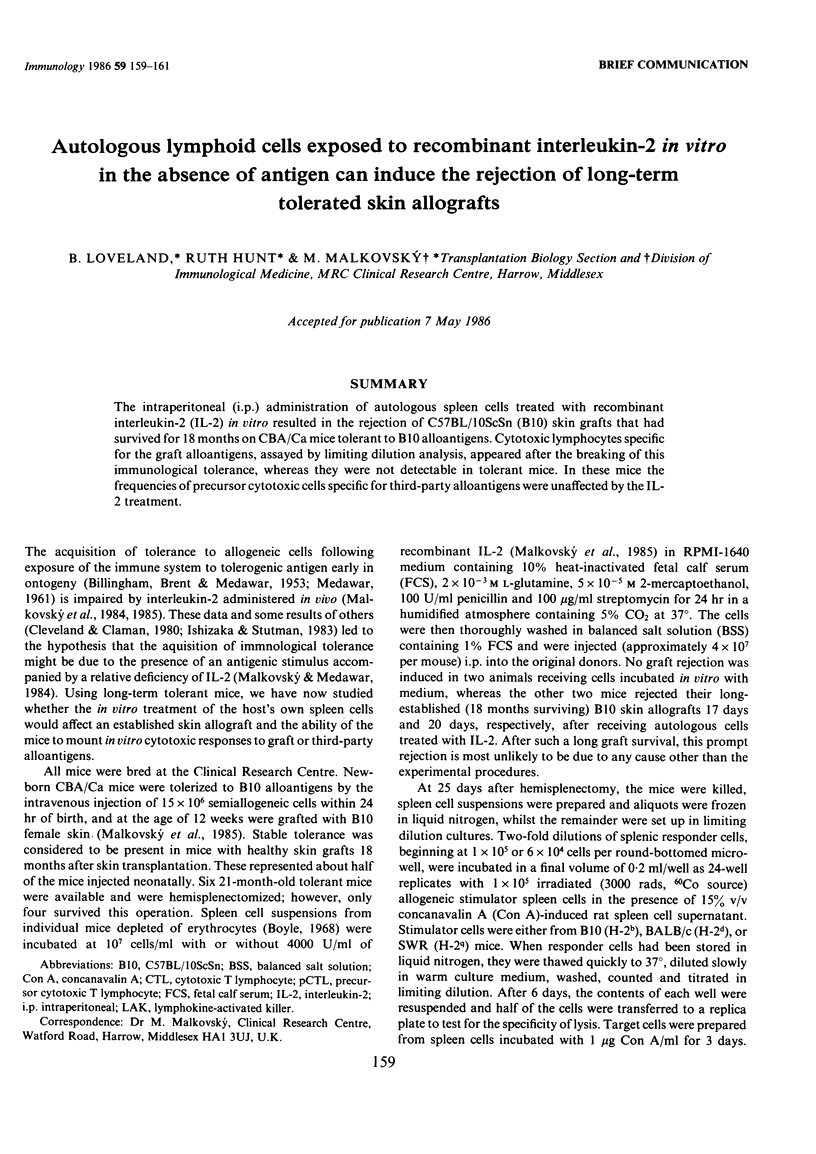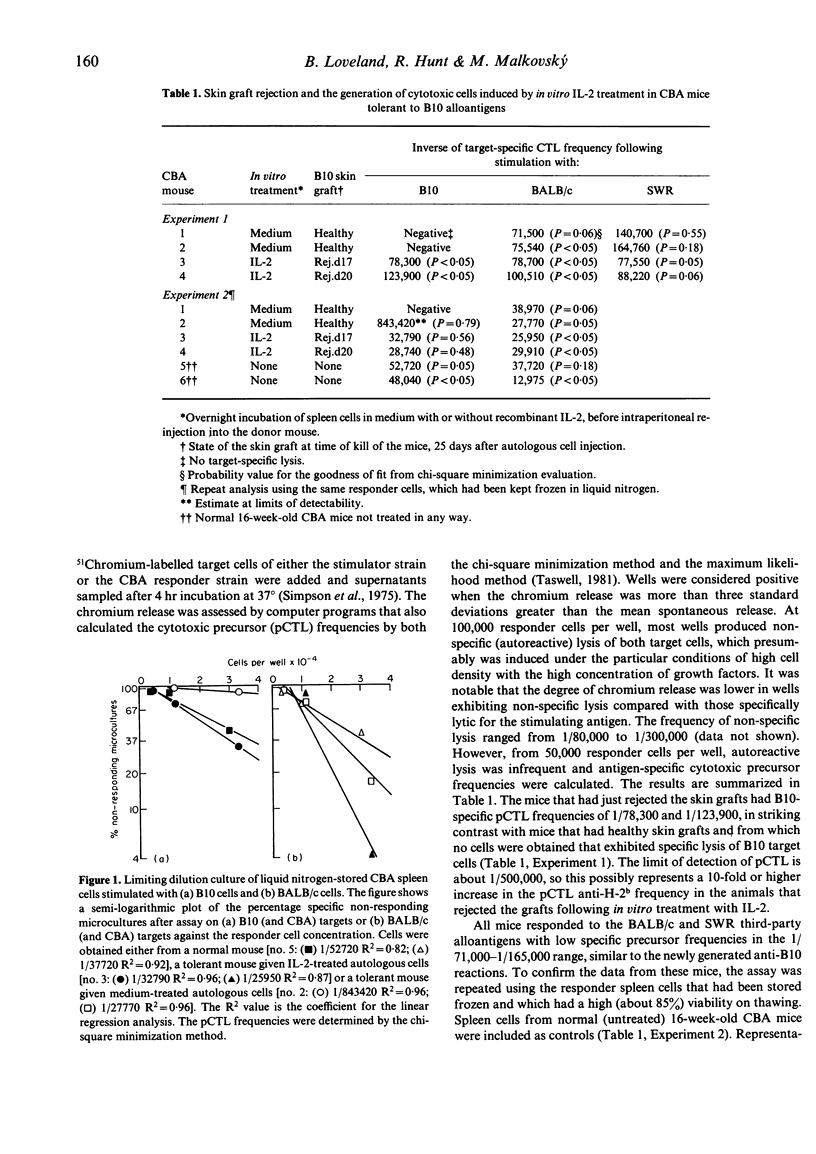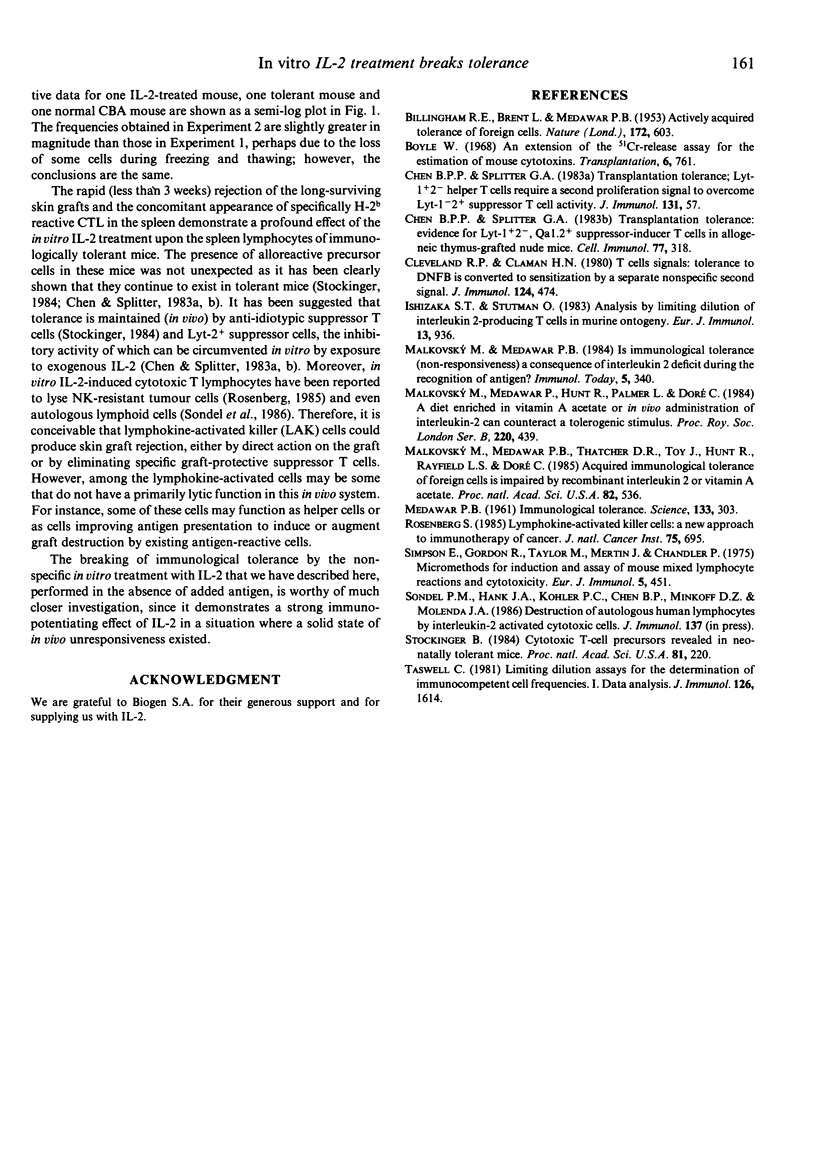Abstract
The intraperitoneal (i.p.) administration of autologous spleen cells treated with recombinant interleukin-2 (IL-2) in vitro resulted in the rejection of C57BL/10ScSn (B10) skin grafts that had survived for 18 months on CBA/Ca mice tolerant to B10 alloantigens. Cytotoxic lymphocytes specific for the graft alloantigens, assayed by limiting dilution analysis, appeared after the breaking of this immunological tolerance, whereas they were not detectable in tolerant mice. In these mice the frequencies of precursor cytotoxic cells specific for third-party alloantigens were unaffected by the IL-2 treatment.
Full text
PDF


Selected References
These references are in PubMed. This may not be the complete list of references from this article.
- BILLINGHAM R. E., BRENT L., MEDAWAR P. B. Actively acquired tolerance of foreign cells. Nature. 1953 Oct 3;172(4379):603–606. doi: 10.1038/172603a0. [DOI] [PubMed] [Google Scholar]
- Boyle W. An extension of the 51Cr-release assay for the estimation of mouse cytotoxins. Transplantation. 1968 Sep;6(6):761–764. doi: 10.1097/00007890-196809000-00002. [DOI] [PubMed] [Google Scholar]
- Chen B. P., Splitter G. A. Transplantation tolerance: Lyt-1+2- helper T cells require a second proliferation signal to overcome Lyt- 1-2+ suppressor T cell activity. J Immunol. 1983 Jul;131(1):57–63. [PubMed] [Google Scholar]
- Chen B. P., Splitter G. A. Transplantation tolerance: evidence for Lyt 1+,2-,Qa 1.2+ Suppressor-inducer T cells in allogeneic thymus-grafted nude mice. Cell Immunol. 1983 Apr 15;77(2):318–328. doi: 10.1016/0008-8749(83)90032-1. [DOI] [PubMed] [Google Scholar]
- Cleveland R. P., Claman H. N. T cell signals: tolerance to DNFB is converted to sensitization by a separate nonspecific second signal. J Immunol. 1980 Jan;124(1):474–480. [PubMed] [Google Scholar]
- Ishizaka S. T., Stutman O. Analysis by limiting dilution of interleukin 2-producing T cells in murine ontogeny. Eur J Immunol. 1983 Nov;13(11):936–942. doi: 10.1002/eji.1830131113. [DOI] [PubMed] [Google Scholar]
- MEDAWAR P. B. Immunological tolerance. Science. 1961 Feb 3;133(3449):303–306. doi: 10.1126/science.133.3449.303. [DOI] [PubMed] [Google Scholar]
- Malkovský M., Medawar P. B., Thatcher D. R., Toy J., Hunt R., Rayfield L. S., Doré C. Acquired immunological tolerance of foreign cells is impaired by recombinant interleukin 2 or vitamin A acetate. Proc Natl Acad Sci U S A. 1985 Jan;82(2):536–538. doi: 10.1073/pnas.82.2.536. [DOI] [PMC free article] [PubMed] [Google Scholar]
- Malkovský M., Medawar P., Hunt R., Palmer L., Doré C. A diet enriched in vitamin A acetate or in vivo administration of interleukin-2 can counteract a tolerogenic stimulus. Proc R Soc Lond B Biol Sci. 1984 Feb 22;220(1221):439–445. doi: 10.1098/rspb.1984.0012. [DOI] [PubMed] [Google Scholar]
- Simpson E., Gordon R., Taylor M., Mertin J., Chandler P. Micromethods for induction and assay of mouse mixed lymphocyte reactions and cytotoxicity. Eur J Immunol. 1976 Jul;5(7):451–455. doi: 10.1002/eji.1830050705. [DOI] [PubMed] [Google Scholar]
- Stockinger B. Cytotoxic T-cell precursors revealed in neonatally tolerant mice. Proc Natl Acad Sci U S A. 1984 Jan;81(1):220–223. doi: 10.1073/pnas.81.1.220. [DOI] [PMC free article] [PubMed] [Google Scholar]
- Taswell C. Limiting dilution assays for the determination of immunocompetent cell frequencies. I. Data analysis. J Immunol. 1981 Apr;126(4):1614–1619. [PubMed] [Google Scholar]


